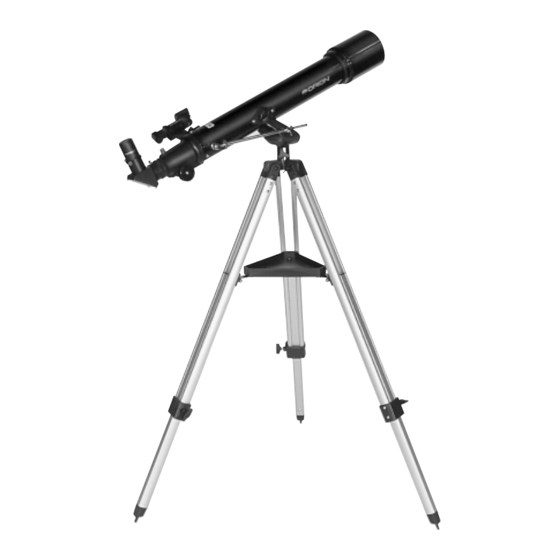Table of Contents
Advertisement
Quick Links
Advertisement
Table of Contents

Summary of Contents for ORION TELESCOPES & BINOCULARS Observer 70mm AZ 9881
- Page 1 INSTRUCTION MANUAL Orion ® Observer 70mm AZ ™ #9881 Altazimuth Refractor Telescope Customer Support (800) 676-1343 E-mail: support@telescope.com Corporate Offices (831) 763-7000 P.O. Box 1815, Santa Cruz, CA 95061 Providing Exceptional Consumer Optical Products Since 1975 IN 210 Rev. A 10/02...
-
Page 3: Table Of Contents
® elcome to the exciting world of amateur astronomy. Your new Observer 70 Altazimuth Refractor is a quality optical instrument that will deliver countless hours of exciting stargazing, from magnified views of the Moon, star clusters and nebulas to glimpses of Jupiter’s moons and Saturn’s rings. The Observer 70 includes everything you need to go from box to backyard in less than half an hour. - Page 4 Observer 70 Refractor Figure 1. Observer 70 Components.
-
Page 5: The Basic Components Of
® 3. The Basic Components of Your Telescope Figure 1 shows the fully assembled Observer 70. All the major components of the telescope are described and numbered to help you identify each part and understand its use. Refer back to this figure when assembling the telescope. Optical tube EZ Finder II reflex sight This is the main optical component of the telescope. - Page 6 Observer 70 Telescope Tube Figure 2a. Optical tube components. Figure 2b. Observer 70 focuser detail.
- Page 7 ® Details of the Optical Tube and Components Figure 2a shows the details of the optical tube (1) and its various parts. The optical tube is shown attached to the mount for clar- ity. Figure 2b is a close up of the focuser with even more detail. Objective lens Focuser drawtube This is the main optical component of the telescope.
- Page 8 Observer 70 Tripod and Mount Figure 3a. Tripod and mount detail. Figure 3b. Observer 70 Tripod leg and mount attachment detail.
- Page 9 Details of the Tripod and Mount Figure 3a shows a close up of the telescope’s mount and tripod. Important features are pointed out for greater clarity and detail. Figure 3b shows a close-up detail of the tripod legs (6) attached to the altazimuth yoke mount (5). Altitude lock knob Leg lock knobs This locks the telescope in the altitude (up/down) direc-...
-
Page 10: Assembly
4. Assembly Assembling the telescope for the first time should take about 30 minutes. The only tools you will need are a Phillips head screwdriver and a flat head screwdriver. As a general note, tighten all screws securely to eliminate flexing and wobbling, but be careful not to over-tighten and thereby strip the threads. - Page 11 Do You Wear Eyeglasses? Altitude If you wear eyeglasses, you may be able to keep them on while you observe. In order to do this, your eyepiece must have enough “eye relief” to allow you to see the entire field of view with glasses on. You can try looking through the eyepiece first with your glasses on and then with them off, to see if the glasses restrict the view to only a portion of the full field.
-
Page 12: Using Your Telescope
Aligning the EZ Finder II When the EZ Finder II is properly aligned with the telescope, Azimuth an object that is centered on the EZ Finder II’s red dot should adjustment wheel also appear in the center of the field of view of the telescope’s eyepiece. - Page 13 Light Pollution Most of us live where city lights interfere with our view of the heavens. As our metropolitan areas have become more developed, the scourge of light pollution has spread, washing out many stars and nonstellar celestial objects from our sight. Faint deep sky objects become difficult or impossible to see through the murk of light pollution.
- Page 14 To calculate the magnification, or power, of a telescope-eye- Magnification Limits piece combination, simply divide the focal length of the tele- scope by the focal length of the eyepiece: Every telescope has a useful magnification limit of about 2X per millimeter of aperture. This comes to 140X for the Telescope Focal Length (mm) = Magnification Observer 70.
-
Page 15: Care And Maintenance
C. The Planets you become more experienced and your observing skills get sharper, you will be able to ferret out more and more subtle The planets don’t stay put like the stars, so to find them you details and structure. should refer to Sky Calendar at our website (telescope.com), or to charts published monthly in Astronomy, Sky &... -
Page 16: Specifications
8. Specifications Optical tube: Aluminum Objective lens diameter: 70mm Objective lens: Achromatic, air-spaced, multi-coated Focal length: 700mm Focal ratio: f/10.0 Focuser: Rack and pinion, accepts 1.25" eyepieces Eyepieces: 25mm and 10mm Explorer II eyepieces, 1.25" Magnification: 28x (with 25mm) and 70x (with 10mm) Finder: EZ Finder II reflex sight Tripod: Aluminum Mount: Altazimuth yoke, fine adjustment for altitude...

















Need help?
Do you have a question about the Observer 70mm AZ 9881 and is the answer not in the manual?
Questions and answers